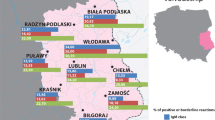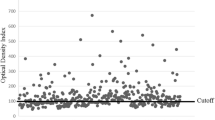Abstract
In 1992 blood samples were taken from 630 forestry workers in the state of Brandenburg, Germany, and an inquiry about tick bites and possible symptoms of Lyme borreliosis carried out in order to determine the seroprevalence of the disease. To estimate the rate of seroconversion within six months, 406 of the individuals were investigated a second time. IgG and IgM antibodies againstBorrelia burgdorferi were detected in serum using an indirect immunofluorescence assay (IFA) and an immunoblot assay (IBA). Fifty-three percent of the forestry workers reported suffering a tick bite, 8% of whom recalled an erythema after the bite. Positive results were found more frequently in the forestry workers than in a control group of 200 healthy blood donors in both the IgG-IFA (8% vs. 4%, p<0.05) and the IgG-IBA (18% vs. 5%, p<0.05). The detection of IgG antibodies correlated with a tick bite and erythema history. There was a tendency of lower seropositivity by the IgG-IBA in individuals who treated the ticks before removal with chemicals or other agents compared to those without such treatment (16.8% vs. 23.9%, 0.05 >p<0.1). Likewise, there was a tendency of lower seropositivity by the IgG-IFA in individuals being treated with antibiotics for other reasons compared to untreated individuals (3.15% vs. 8.9%, p<0.05), although the two groups did not differ in the IgG-IBA (13.8% vs. 18.5%, p>0.1). The rate of seroconversion within six months ranged from 5 to 7%. It is concluded that forestry workers in Brandenburg, Germany, are at risk for infection withBorrelia burgdorferi, but clinical signs of infection are rare.
Similar content being viewed by others
References
Jaenson TGT: The epidemiology of Lyme borreliosis. Parasitology Today 1991, 7: 39–45.
Steere AC: Lyme disease. New England Journal of Medicine 1989, 321: 586–596.
Berglund J, Eitrem R: Tick-borne borreliosis in the archipelage of southern Sweden. Scandinavian Journal of Infectious Diseases 1993, 25: 67–72.
Blaauw I, Nohlmans L, van den Bogaard T, van der Linden S: Diagnostic tools in Lyme borreliosis: clinical history compared with serology. Journal of Clinical Epidemiology 1992, 45: 1229–1236.
Cinco M, Balanzin D, Benussi R Trevisan G: Seroprevalence and incidence of Lyme Borreliose in forestry workers in Friuli Venezia Giulia (Northern Italy). Alpe Andria Microbiology Journal 1993, 2: 91–98.
Fahrer H, Sauvain MJ, van der Linden S, Zhioua E, Gern L, Aeschlimann A: Prävalenz der Lyme-borreliosis in einer schweizerischen Risikopopulation. Schweizerische Medizinische Wochenschrift 1988, 118: 65–69.
Gern L, Frossard E, Walter A, Aeschlimann A: Presence of antibodies againstBorrelia burgdorferi in a population of the Swiss plateau. Zentralblatt für Bakteriologie 1989, Supplement 18: 321–328.
Goldstein MD, Schwartz BS, Friedmann C, Maccarillo B, Borbi M, Tuccillo R: Lyme disease in New Jersey outdoor workers: a statewide survey of seroprevalence and tick exposure. American Journal of Public Health 1990, 80: 1225–1229.
Gustafson R, Svenungsson B, Gardulf A, Stiernstedt G, Forsgren M: Prevalence of tick-borne encephalitis and Lyme borreliosis in a defined Swedish population. Scandinavian Journal of Infectious Diseases 1990, 22: 297–306.
Gustafson R, Forsgren M, Gardulf A, Grandström M, Svenungsson B: Antibody prevalence and clinical manifestations of Lyme borreliosis and tick-borne encephalitis in Swedish orienteers. Scandinavian Journal of Infectious Diseases 1993, 25: 605–611.
Guy EC, Bateman DE, Martyn CN, Heckels JE, Lawton NF: Lyme disease: prevalence and clinical importance ofBorrelia burgdorferi specific IgG in forestry workers. Lancet 1989, i: 484–486.
Hassler D, Zöller L, Haude M, Hufnagel HD, Sonntag HG: Lyme-Borreliose in einem europäischen Endemiegebiet. Deutsche Medizinische Wochenschrift 1992, 117: 767–774.
Huycke MM, D'Alessio DD, Marx JJ: Prevalence of antibodies toBorrelia burgdorferi by indirect fluorescent antibody assay, ELISA, and Western immunoblot in healthy adults in Wisconsin and Arizona. Journal of Infectious Diseases 1992, 165: 1133–1137.
Kuiper H, de Jongh BM, Nauta AP, Houweling H, Wiessing LG, Moll van Charante AW, Spanjaard L: Lyme borreliosis in Dutch forestry workers. Journal of Infection 1991, 23: 279–286.
Kuiper H, van Dam AP, Moll van Charante AW, Nauta NP, Dankert J: One year follow-up study to assess the prevalence and incidence of Lyme borreliosis among Dutch forestry workers. European Journal of Clinical Microbiology & Infectious Diseases 1993, 12: 413–418.
Lane RS, Manweiler SA, Stubbs HA, Lennette ET, Madigan JE, Lavoie PE: Risk factors for Lyme disease in a small rural community in northern California. American Journal of Epidemiology 1992, 136: 1358–1368.
Münchhoff P, Wilske B, Preac-Mursic V, Schierz G: Antibodies againstBorrelia burgdorferi in Bavarian forest workers. Zentralblatt für Bakteriologie Reihe A 1986, 263: 412–419.
Nadal D, Wunderli W, Briner H, Hansen K: Prevalence of antibodies toBorrelia burgdorferi in forestry workers and blood donors from the same region in Switzerland. European Journal of Clinical Microbiology & Infectious Diseases 1989, 8: 992–995.
Neubert U, Münchhoff P, Völker B, Reimers CD, Pflüger KH:Borrelia burgdorferi infections in Bavarian forest workers. Annals of the New York Academy of Sciences 1988, 539: 476–479.
Pejcoch M, Kralikova Z, Strnad P, Stanek G: Prevalence of antibodies toBorrelia burgdorferi in forestry workers of south Moravia. Zentralblatt für Bakteriologie 1988, Supplement 18: 317–320.
Pierer K, Köck T, Freidl W, Stünzner D, Pierer G, Marth E, Lechner H, Möse JR: Prevalence of antibodies toBorrelia burgdorferi flagellin in Syrian blood donors. Zentralblatt für Bakteriologie 1993, 279: 239–243.
Rees DHE, Axford JS: Evidence for Lyme disease in urban park workers: a potential new health hazard for city inhabitants. British Journal of Rheumatology 1994, 33: 123–128.
Satz N, Ackermann R, Gern L, Aeschlimann A, Ott A, Knoblauch M: Zur Epidemiologie der Infektion mitBorrelia burgdorferi. Schweizerische Medizinische Wochenschrift 1988, 118: 422–426.
Schmidt R, Gollmer E, Zunser R, Krüger J, Ackermann R: Prevalence of erythema migrans borreliosis in blood donors. Infusionstherapie 1989, 16: 248–251.
Schwartz BS, Goldstein MD: Lyme disease in outdoor workers: risk factors, preventive measures, and tick removal methods. American Journal of Epidemiology 1990, 131: 877–885.
Smith PF, Benach JL, White DJ, Stroup DF, Morse DL: Occupational risk of Lyme disease in endemic areas of New York State. Annals of the New York Academy of Sciences 1988, 539: 289–301.
Sticht-Groh V, Martin R, Schmidt-Wolf I: Antibody titer determinations againstBorrelia burgdorferi in blood donors and two different groups of patients. Annals of the New York Academy of Sciences 1988, 539: 497–499.
Wilske B, Münchhoff P, Schierz G, Preac-Mursic V, Roggendorf M, Zoulek G: Zur Epidemiologie derBorrelia burgdorferi-Infektion. Münchner Medizinische Wochenschrift 1985, 127: 171–172.
Bakken LL, Case KL, Callister SM, Bourdeau NJ, Schell RF: Performance of 45 laboratories participating in a proficiency testing program for Lyme disease serology. Journal of the American Medical Association 1992, 268: 891–895.
Zöller L, Burkard S, Schäfer H: Validity of Western immunoblot band pattern in the serodiagnosis of Lyme borreliosis. Journal of Clinical Microbiology 1991, 29: 174–182.
Ma B, Christen B, Leung D, Vigo-Pelfrey C: Serodiagnosis of Lyme borreliosis by Western immunoblot: reactivity of various significant antibodies againstBorrelia burgdorferi. Journal of Clinical Microbiology 1992, 30: 370–376.
Dressler F, Whalen JA, Reinhardt BN, Steere AC: Western blotting in the serodiagnosis of Lyme disease. Journal of Infectious Diseases 1993, 167: 392–400.
Rath P-M, Marsch W, Brade V, Fehrenbach F-J: Serological distinction between syphilis and Lyme borreliosis. Zentralblatt für Bakteriologie 1994, 280: 319–324.
Author information
Authors and Affiliations
Rights and permissions
About this article
Cite this article
Rath, P.M., Ibershoff, B., Mohnhaupt, A. et al. Seroprevalence of lyme borreliosis in forestry workers from Brandenburg, Germany. Eur. J. Clin. Microbiol. Infect. Dis. 15, 372–377 (1996). https://doi.org/10.1007/BF01690092
Issue Date:
DOI: https://doi.org/10.1007/BF01690092




